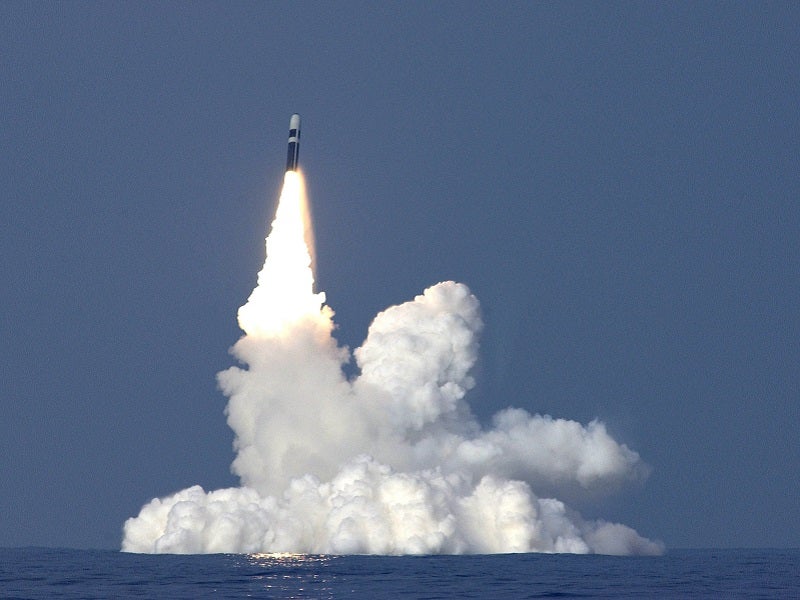
The US Navy (USN) is looking to reduce the build time of its Columbia-class ballistic missile submarines (SSBN) from the current 84 months down to 78 months, in a bid to reduce the potential for gaps as the incumbent Ohio class gradually leaves service.
The Columbia class is the USN’s main acquisition priority and is scheduled to see its first delivery in 2027, with the introduction into service of the future USS District of Columbia. The vessels, at 580ft in length and displacing 20,810t, will be the largest class of submarines ever built by the US and are expected to remain in service until around 2080.
Providing an update to the Columbia programme during a Mitchell Institute event on 24 August, Rear Admiral Scott Pappano, programme executive officer for strategic submarines at the USN, said that the Columbia build was a “priority” for the service.
Pappano added that the current build schedule for the first-in-class was slated to be 84 months, although efforts were underway to reduce that by up to half a year. “We have worked on [planning for] a 78-month delivery schedule, we are behind that now [and] still at 84 months.”
The US shipbuilding sector has faced a number of challenges over the decades as the national economy transitions from one based on manufacturing, to rely heavily on the service sector. Add to this supply chain problems felt throughout industry as a result of the Covid-19 pandemic, and with the facility at Newport News also responsible for the nuclear-powered Virginia-class SSN and Ford-class aircraft carrier programmes, and the challenges in maintaining the Ohio build schedule become clear.
On 4 June this year the USN held a keel laying ceremony for the future USS District of Columbia, the lead boat of a 12-hull class, replacing the 14-boat Ohio SSBNs. The USN, alongside industry partner Electric Boat, began the conceptual designs for Columbia in 2007 as a replacement for the Ohio-class SSBNs.
“We want at least 12 Columbia SSBNs,” said Pappano, who added that it would “certainly reduce the risk” if a decision were taken to acquire an additional two hulls, which could be made towards the end of the decade.

The Columbia class will initially carry 16 D5 nuclear ballistic missiles each, which in total represent approximately 70% of the US nuclear triad. It is planned that the upgraded D5LE2 ballistic missile will be installed on the Columbia class from boat nine onwards.
The D5LE2 progamme is being developmed concurrently with that of the Columbia build, as well as that of the UK’s Dreadnought SSBN programme, which will see four new submarines replace the Vanguard class currently in service.
Capacity issues for AUKUS
Regarding the AUKUS grouping, which will see the US, UK, and Australia create a new Asia-Pacific security alliance, Pappano said that any move to see the planned class of nuclear-powered hunter-killer submarines sought by Australia to be built in US shipyards would have a negative impact on programmes such as the Columbia class.
In 2021, Australia announced its decision to withdraw from its agreement with French shipbuilder Naval Group to manufacture six conventionally powered submarines based on the nuclear-powered Barracuda design. Instead, Canberra would seek to develop a class of nuclear-powered submarines that it said would be more suited to operating in the oceanic expanses of the Asia-Pacific.
An 18-month study to determine the best ways to deliver a nuclear-powered submarine fleet to Australia through the AUKUS alliance will come to a conclusion at the end of Q1 2023.
Like those in the US, the UK’s nuclear submarine manufacturing site at BAE Systems’ site in Barrow-in-Furness has little spare capacity to plug in new orders. The site is currently engaged in building the final two boats of the Astute-class hunter killer fleet (the future HMS Agamemnon and HMS Agincourt), while beginning the first-in-class of a four-boat build of the Vanguard-class SSBN replacement which will carry Britain’s nuclear deterrent.
“If we were going to add additional [Australian] submarine construction to our base that would be detrimental right now. I think that exists for both US and the UK,” Pappano said.
A leading global exporter of uranium, a key element in the creation of nuclear energy, Australia does not have a civil industrial or military nuclear sector. Should Canberra acquire or develop nuclear-powered submarines, it would become the first-non-nuclear state to do so.
Significant issues remain for Australia in its pursuit of a fleet of SSNs, as it would rely heavily on the technical, military, and industrial knowhow of the US and UK, while also relying on Washington and London for the nuclear fuel and the navalised reactors required to power such vessels.
In September 2021, the International Atomic Energy Agency (IAEA) released a statement regarding Australia’s planned development of SSNs, noting that the three countries of the AUKUS alliance had notified the IAEA in advance of the public announcement.
“The IAEA will engage with them on this matter in line with its statutory mandate, and in accordance with their respective safeguards agreements with the agency,” the IAEA said in a statement at the time.
Australia is a signatory state, along with the US and UK, to the IAEA’s nuclear non-proliferation act, intended to stop the development and spread of nuclear weapons.




